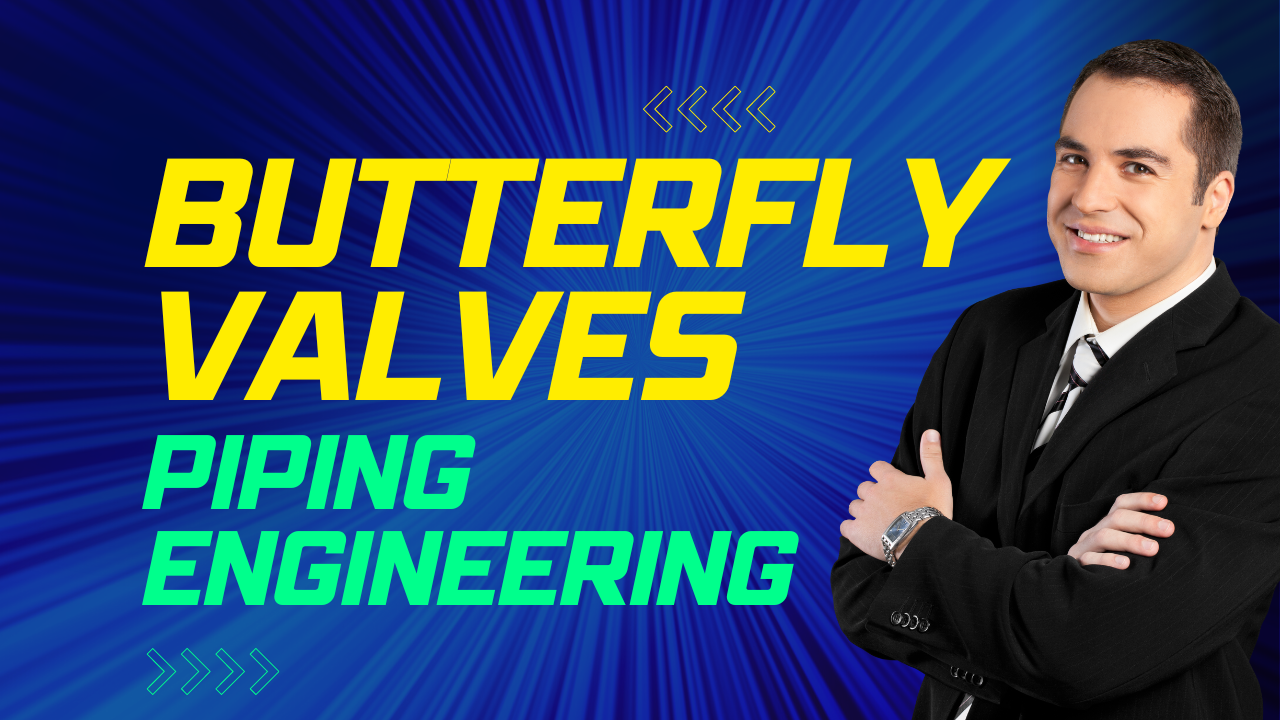Introduction:
In the realm of flow control, Butterfly Valves play a crucial role. These innovative devices offer efficient regulation of fluid and gas flow across various industries. In this detailed guide, we’ll delve into the world of Butterfly Valves, exploring their mechanisms, types, applications, and maintenance. Whether you’re a seasoned professional or just curious about this technology, this article will provide valuable insights and expertise. Check out the details of ASME B31.3 here.
Table of Contents
Butterfly Valves: A Quick Overview
Butterfly Valves are versatile flow control devices used to regulate fluid and gas flow within pipelines. They consist of a circular disc that pivots on a central axis, allowing for precise control of flow rates. Due to their compact design and exceptional control capabilities, these valves have become a popular choice in various industries.
Don’t miss the Complete Course on Piping Engineering: Check Now
By EPCLand.com
Types of Butterfly Valves
There are three primary types of Butterfly Valves: Concentric, Eccentric, and Double Offset. Each type offers distinct advantages and is suitable for specific applications.
1. Concentric Butterfly Valves
Concentric Butterfly Valves feature a disc with its center of mass at the same point as the shaft. These valves are cost-effective, easy to install, and ideal for low-pressure applications like water and air.
2. Eccentric Butterfly Valves
Eccentric Butterfly Valves have a slightly offset disc center, providing better sealing performance and reduced wear. They are commonly used in applications with moderate pressures and temperatures.
3. Double Offset Butterfly Valves
Double Offset Butterfly Valves have both the disc center and shaft offset, ensuring optimal sealing performance even in high-pressure and high-temperature conditions. They find applications in industries dealing with corrosive fluids and extreme conditions.
Applications of Butterfly Valves
Butterfly Valves find applications across a wide range of industries due to their versatile design and efficient control capabilities.
1. Water Treatment
In water treatment plants, Butterfly Valves regulate the flow of water, allowing precise control over treatment processes such as sedimentation, filtration, and disinfection.
2. HVAC Systems
Heating, Ventilation, and Air Conditioning (HVAC) systems use Butterfly Valves to control the flow of air and water, maintaining optimal temperatures and air quality in buildings.
3. Petrochemical Industry
The petrochemical industry employs Butterfly Valves in pipelines to control the flow of various fluids, including gases and liquids, during refining processes.
4. Food and Beverage
In food and beverage production, these valves manage the flow of ingredients, liquids, and gases, ensuring efficient processing and packaging.
5. Pharmaceutical Manufacturing
Butterfly Valves play a critical role in pharmaceutical manufacturing, enabling precise control over the flow of liquids and gases during various production stages.
Advantages of Butterfly Valves
The widespread adoption of Butterfly Valves can be attributed to their numerous advantages:
- Compact Design: Their space-saving design makes them an ideal choice for applications with limited space.
- Quick Operation: Butterfly Valves can be rapidly opened or closed, allowing for swift response to changing flow requirements.
- Cost-Effective: Their simple construction and ease of installation result in lower maintenance and operational costs.
- Low Pressure Drop: These valves exhibit minimal resistance to flow, ensuring efficient fluid transportation.
- Versatility: From low to high-pressure applications, Butterfly Valves can handle a broad range of conditions.
- Easy Automation: They can be easily integrated into automated control systems for seamless operation.
Maintenance and Care
Proper maintenance is essential to ensure the longevity and reliable performance of Butterfly Valves.
- Regular Inspections: Periodic checks for wear, corrosion, and leakage are crucial to catch issues early.
- Lubrication: Proper lubrication of moving parts reduces friction and extends the valve’s lifespan.
- Seal Replacement: Damaged seals should be promptly replaced to maintain effective sealing and prevent leaks.
- Cleaning: Keeping the valve clean from debris and contaminants prevents blockages and maintains smooth operation.
FAQs
Q: How do Butterfly Valves work? A: Butterfly Valves use a circular disc to control flow by pivoting around a central axis, either allowing or obstructing the passage of fluids or gases.
Q: Are Butterfly Valves suitable for high-pressure applications? A: Yes, Double Offset Butterfly Valves are designed to handle high-pressure and high-temperature conditions with their offset disc and shaft design.
Q: Can Butterfly Valves be automated? A: Absolutely, Butterfly Valves are often integrated into automated control systems, enhancing efficiency and accuracy in flow regulation.
Q: What is the advantage of using Eccentric Butterfly Valves? A: Eccentric Butterfly Valves provide better sealing performance due to their slightly offset disc center, reducing wear and improving overall efficiency.
Q: How can I maintain Butterfly Valves? A: Regular inspections, lubrication, seal replacement, and proper cleaning are essential for the maintenance of Butterfly Valves.
Q: Where can I find more information about industrial valves? A: For more information, you can visit reputable sources like Wikipedia’s Valve page.
Conclusion
Butterfly Valves have revolutionized flow control in various industries, offering efficient and precise regulation of fluids and gases. With their versatile design, cost-effectiveness, and ease of automation, these valves continue to play a pivotal role in optimizing industrial processes. By understanding their types, applications, advantages, and maintenance, professionals can make informed decisions to enhance their operations and achieve optimal flow control.
Recommended courses (Published on EPCLand):
- Basics of Piping Engineering
- Piping Layout Engineering
- Piping Material Engineering
- Piping Stress Analysis
- Complete Course on Piping Engineering
- Material Requisitions
- Piping Material Specifications
- Valve Material Specifications
Related Video
Attempt Quiz
Question 1:
What is a butterfly valve?
Explanation: A butterfly valve is a device used to control the flow of liquids, gases, or slurries in a pipe. It consists of a circular disc that rotates to open or close the valve.
Question 2:
Which of the following is a common application of butterfly valves?
Explanation: Butterfly valves are commonly used in HVAC (Heating, Ventilation, and Air Conditioning) systems to regulate the flow of air and water.
Question 3:
What is the advantage of using a butterfly valve?
Explanation: One of the advantages of using a butterfly valve is its quick opening and closing mechanism, which allows for efficient flow control.
Question 4:
Which type of butterfly valve has a rubber-lined disc?
Explanation: The wafer butterfly valve typically has a rubber-lined disc, making it suitable for various applications, including water and mild chemicals.
Question 5:
What is the function of the disc in a butterfly valve?
Explanation: The disc in a butterfly valve is responsible for opening and closing the valve by rotating around an axis, allowing or restricting the flow of fluid.



